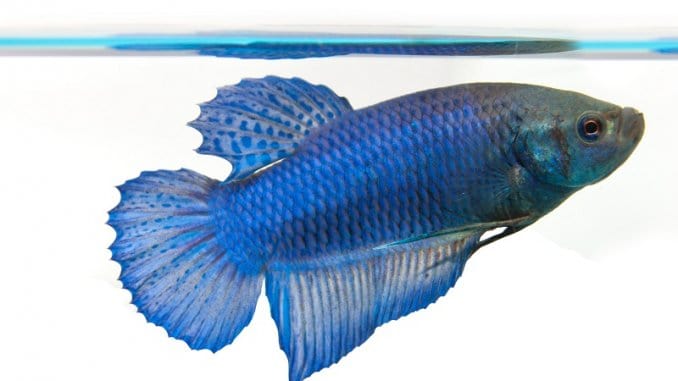
Male or female bettas are beautiful, rewarding fish for any aquarium keeper. Males are known for their vibrant colors and long, flowing fins, whereas females tend to have noticeably smaller fins and tails.
Unlike males, female betta fish can be kept together in one tank. A group of female bettas is known as a sorority. This article will discuss how to care for female bettas.
TABLE OF CONTENTS
Female Betta Fish: A Quick Guide
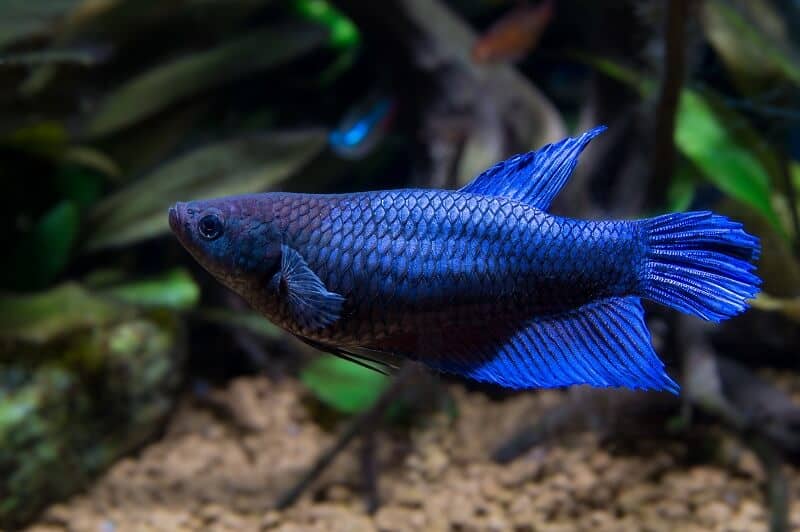
Caring for a female betta fish is very similar to caring for a male betta. For example, both males and females need the same kind of tank size and water conditions, although their temperaments are different. Let’s discuss a few key points which will help you care for your female betta fish.
- Lifespan: Both male and female bettas live for up to 3 years. With proper care, bettas have been known to live longer than this
- How to tell if a betta fish is female: Female betta fish have smaller fins than the males and are slightly smaller and slimmer. They are less vibrant and have an egg spot. Side by side, it’s very easy to tell a male betta apart from a female. It’s more difficult to tell males and females apart before they reach maturity
- Size: Betta females grow up to 2.5–3 inches, which is slightly smaller than the average male betta
- Tank size: A single female betta fish needs at least a 5-gallon tank. If you plan to keep a sorority, you’ll need at least a 20-gallon tank
Water type: Freshwater, with a pH of 6.5–7.5, and a temperature of 78–80°F - Food: Female betta fish are carnivorous, like the males, and should be fed a diet of fish pellets specifically for bettas. You can also feed your betta snacks such as bloodworms or even finely chopped meat
- Temperament: Females are less aggressive and territorial than male bettas, but some individual bettas can still be aggressive. However, female betta fish can be kept with other female bettas. Female betta fish are less showy than males, but that doesn’t mean that they’re any less rewarding to keep and care for
Female Betta Fish Behavior and Care

Every fish has its own unique needs and characteristics, and female bettas are no exception. Even if you’re used to keeping males bettas, looking after females is a new experience because they have a few different needs.
Let’s discuss the key elements you need to know before bringing home a female betta.
Behavior
Female betta fish are less aggressive than males, but any kind of betta fish will display aggression and territorial behavior. Remember, bettas are called “Siamese fighting fish” for a reason. While female betta fish can and do live comfortably together (which certainly can’t be said of male bettas), there may be fighting and other incidents.
Any sorority will take some time to get comfortable with each other, and social order will need to be established first. Some individual female betta fish are too aggressive to be kept with others.
Keep a close eye on your fish, and learn their personalities. This is especially important when you first bring your fish home. Moving to a new tank can be stressful, and stress can encourage other problems, like aggression and territorial behavior.
Finding tank mates for female betta fish is easier than finding mates for males. When choosing tank mates for a male, you need to be careful not to choose a showy fish that could be mistaken for another male. Female betta fish are much more tolerant of other fish. However, a female betta will still act aggressively if it feels threatened, so be sure to pick peaceful fish as tank mates.
Starting and Maintaining a Sorority
A sorority is made up of four to six female bettas, preferably all of the same age. It’s important to give the sorority as much tank room as possible. Any tank smaller than 20 gallons can lead to aggressive behavior, as the female bettas feel cramped and threatened.
Once you’ve added your sorority to a tank, keep a close eye on the fish. Not every female betta is suited to a sorority, so watch for any aggression or fighting. A social order needs to be established inside the sorority, and this can be a challenge. Have another tank cycled and ready in case one fish needs to be separated from the group.
Don’t add any new fish while your sorority gets established, even if you plan to start a community tank later. Aside from making your bettas feel threatened and cramped, adding new fish can cause the ammonia levels in a tank to spike, which can be fatal for your fish. This is the same for any fish, not just female betta fish.
Tank Conditions/Personal Space
As tropical fish, bettas need warm water of around 78–80°F, with a pH of 6.5–7.5. Male and female betta fish have similar requirements when it comes to tank conditions and water quality. For example, female bettas — just like males — like plenty of places to hide and explore, so feel free to add decorations and hiding spots in the female betta’s tank.
Just like humans, bettas like their own space. This is why decorations, caves, and hiding places are essential. If tensions get high among your sorority or bullying starts to become a problem, your fish should have places to hide.
For a single female betta, you’ll need at least a 5-gallon tank. You’ll need at least 20 gallons if you plan to host a sorority. As with most fish, more space is better. If your bettas feel cramped or threatened, they’ll be more susceptible to illness, and can also become aggressive towards other fish.
It’s best to stick to the 1-inch-per-1-gallon rule, which means that every extra inch of fish needs another gallon of water in the tank. This prevents overcrowding and stress in your aquarium. Always give your bettas at least a month to settle into their new home before adding extra fish.
Laying Eggs
Female betta fish lay eggs after they’ve successfully bred with a male betta. If you decide to breed your bettas, take both the male and female out of their respective tanks and put them into another tank without any other species. The female will need to be removed soon after laying eggs, and the male is left to care for the eggs until they hatch — male bettas make surprisingly good fathers.
Identifying the “egg spot” is a good way to tell male and female bettas apart. The egg spot is a mark on the underside of the female’s body, between her fins and tail. This is where eggs will be laid. The spot is actually the protruding ovipositor and can be noticed on a female betta before the difference in fins becomes obvious.
Female Betta Fish Colors and Types
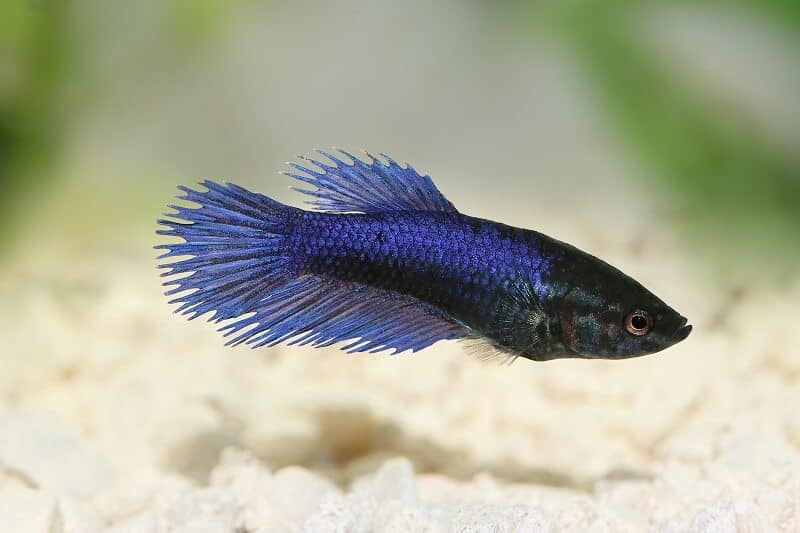
There are fewer types of female betta fish than male bettas, and it can be hard to identify a female’s type. Male bettas are usually the most colorful, but that doesn’t mean females aren’t beautiful too.
There are several types of female betta:
Female Veiltail Bettas
Veiltail bettas are by far the most common type of betta, both male and female. Female veiltails have intense colors, just as spectacular as the males, but their fins and tails are considerably shorter. Female veiltails are available in just about every color you can imagine, due to the extensive breeding of betta fish. Females often have the same patterns as males, such as dragon, butterfly, and marble.
Female Halfmoon Bettas
Halfmoon bettas are known for their fabulous, 180-degree tail fins. Female halfmoons are available in every color and pattern you’ll see on a male halfmoon betta, but the female’s tail and fins are not quite as spectacular as the male’s.
Female Crowntail Bettas
Crowntail, or combtail, bettas have fringed or pointed tails and fins, giving them a “crown” shape. Both male and female crowntails are popular due to their uniquely shaped fins.
Female Koi Bettas
Koi bettas have a distinctive marbled pattern consisting of red, white, gold, black, and orange. Female koi bettas look similar to males, but with shorter fins and tails. Koi bettas and veiltail bettas are the easiest types of bettas to care for.
How to Tell If Your Betta Is a Boy or a Girl
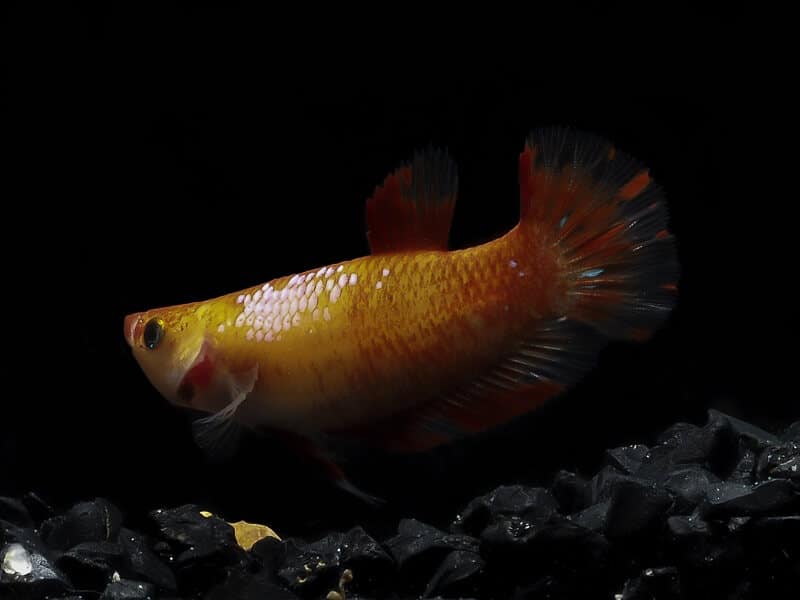
Tail and fin-type can be used to distinguish between male betta fish, but this is less obvious when it comes to females. It’s harder to use tail type to distinguish between females, due to their shorter fins.
Essentially, female bettas look the same as the males, albeit with shorter fins and a few other indicators.
When bettas are young, it’s difficult to tell males and females apart. This is because male and female bettas are both vivacious and beautifully colored and the main difference between these fish — the male’s famous, spectacular fins — haven’t yet grown in.
If you’re worried about accidentally putting males and females in the same tank and ending up with a host of baby bettas, here are a few ways to tell your bettas apart:
Behavior and Temperament
Going by your betta’s behavior alone isn’t the best way to tell males from females, as individual bettas are different. However, males are more territorial and aggressive, especially towards other males.
Some male bettas have been known to be aggressive enough to try and attack their own reflections. While some females can also be aggressive, they’re more peaceful than males and get on well with other females and most other fish.
Color and Fins
The best way to tell male and female betta fish apart is their fins. Males have long, beautiful fins, and females have noticeably shorter fins.
Female bettas often have duller colors in comparison to males, but they are still colorful and beautiful fish. Every color and pattern spectrum is found in both male and female bettas.
Body Shape
Male bettas are slightly larger than females. Males have thicker, heavier bodies, whereas females are smaller and slimmer. The average female grows to around 3 inches, and the average male grows to anywhere between 3–5.5 inches. Male bettas’ long fins also make them seem larger.
Egg Spot
Female betta fish have an ovipositor for laying eggs during mating. This spot can be seen as a protruding, white mark, like a grain of salt, on the underside of the female’s body.
Telling the difference between males and females based on their size while they’re young can be difficult, so spotting the ovipositor is one of the best ways to identify a young female betta fish.
The Bottom Line
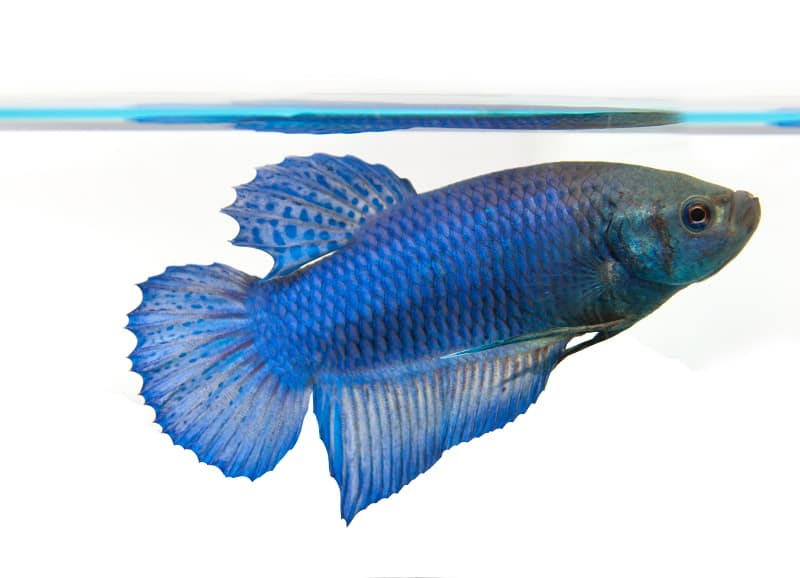
Unfortunately, male bettas seem to get most of the attention from fishkeepers. With their dramatic fins and vibrant colors, males typically stand out more in a fish tank.
Females look a little dull in comparison and can be overlooked in favor of the brighter males. However, female betta fish are beautiful in their own right. These fish have bright colors, vivid patterns, and their own unique personalities.
Female betta fish can also be kept with other bettas, and tend to be more peaceful than males. This can make it easier to create a varied and exciting community tank, with all your fish getting along together. Like male bettas, a female betta’s bright colors can be used as a highlight in a fish tank.
Owning female betta fish can be just as rewarding as owning males, perhaps even more so. Female bettas are entertaining and fascinating, and you won’t have to stress about their behaviors if you choose to keep them in a group. If you’ve never owned bettas before, females are a good option to start with.



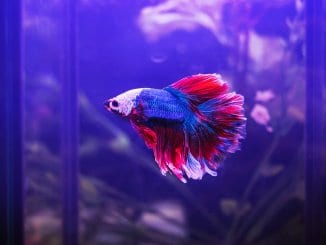



hi sir!! i made a terrible mistake. i have a pair of bettas that i thought i had conditioned well before mixing them to breed.. i had put them in a tank with a clear divider and left it that way for almost a week. on the first days, they are both flaring at each other.. after a few more days, they are flaring less and lesser. only then did i put them in the breeding tank.. to my surprise, after a day, no bubble nest were made (put a little plastic floating there where the male’s supposed to build his nest) and the tail of the female has been nipped.. i separated them immediately.. Some searches lead me to conclude i had over-flared the pair, losing their interest in each other.. :< my question is how long till the female recover her tail?? i have 2 more pairs seeing each other for over a week now, how do i correct this?
I kept a male betta with a dwarf gourami before, and the dwarf gourami kept on nipping his tail on and on. I had to return the gourami. my betta was still young then and is very timid. he is still frightened of my finger and will swim away when i show him pics of other betta. he does not even build a bubble nest which worries me. anyways, his fin grew back in about 1 or 2 weeks.i think it depends on how strong your betta’s will of surving is. he is now living wiyh a cory cat and nerite snail.
PLEASE HELP! I am getting a 20 gallon tank and I want to keep 4 guppies 4 platies 4 neon tetras and 2 cory cat fish would this be to over stocker Thank You so much for helping.
Hope your betta recovers soon!
from my own experience, introduction phase is about 24 hours. introduce them in the breeding tank..with separator. After 24 hours usually the male will be bubble nesting and you can remove the separator.
leave them be for the next 24 hours and usually if everything is well the female will have laid eggs. remove her
keep her in solitary tank with fin medicine…here we use cattapa (indian almond) leaves or extract to recondition her. live food is best
nipped fins usually takes 1 month to heal.
Please help, I have a female betta named Fred. And for a week now Fred has been swimming sideways and hanging at the bottom of the tank. I figured she was bloated soI fasted her for 3 days now and I`ve been trying to feed her about a half of a blanched pea. To no avail, Fred is not showing any interest in eating and is still burrowing herself at bottom of the tank. I love Fred and I don’t want to lose her. What can I do to save my fish?
I have to disagree about female bettas being less colorful than the males, as I have a beautiful multi colored female and have seen others just as colorful as the males. Maybe breeding has lead to brighter and bolder coloring in the females over time. I also find my female betta to be just as charismatic as any male I’ve ever kept — she is a lovely little being!
We have 2 Female Battas and one maie in a community tank (other fishes, Yoyo loaches and Harlecquin Rasboras, also Wood Shrimp). None of the Bettas is noticeable aggresseive to the others, and they ignore the other fishes altotgether, but they certainly interact with each other! The male is pretty laid back and occasionally builds bubble nests but they have not attempted to breed; this is not to say the aren’t interested in each other. I do not particularly want them to breed as I doubt the fry would survive in a cummunity aquarium.
The females are very distincly different characters, one being much more excitable than the other. This fish is a keen jumper and has had to be rescued from the carpet; we keep a close eye on her when the lid is removed for feeding or other access. The ‘quiet’ fish shows more interet in the male, who of course ignores her and chases the other one.
They are fascinating and entertaining fishes that cause no problems and are easy to feed and keep. I may well buy another two females for a ‘sorority’. It is vital to provide hiding places and separtate areas in the tank so that they can make territories; this paradoxically means that they spend more time in the open being entertaining, as the proximity of hidey holes and their own territories gives them confidence. Hopefully the excitable fish, which shows no sign of stress and I’m sure this is simply her nature, will calm down a bit in time; we do worry about her jumping!
First of all I love Betta fish. I had a beautiful male that I lost after I fed him bloodworms. I was so hurt that I never fed any fish blood worms again. I was never going to buy another Betta. Until, I saw this lovely blue fish in the bigger tank at Petco. I didnt even know it was a Betta. She turned out to be a crown tail Betta. I put her in my community 55 gallon tank. I love her so much!!! She is friendly like my angel fish are. She struts all over the tank like a queen. Im going to buy some more female bettas for my other tanks.
I had two females in my tank. One died and the other became aggressive. I tried several times to introduce it into my larger tank and she started attacking all the other fish. So, it now lives by herself in a small 3.5 gallon tank.
How do I tell a male from a female. Do I pick them up and look at them like you do puppies?